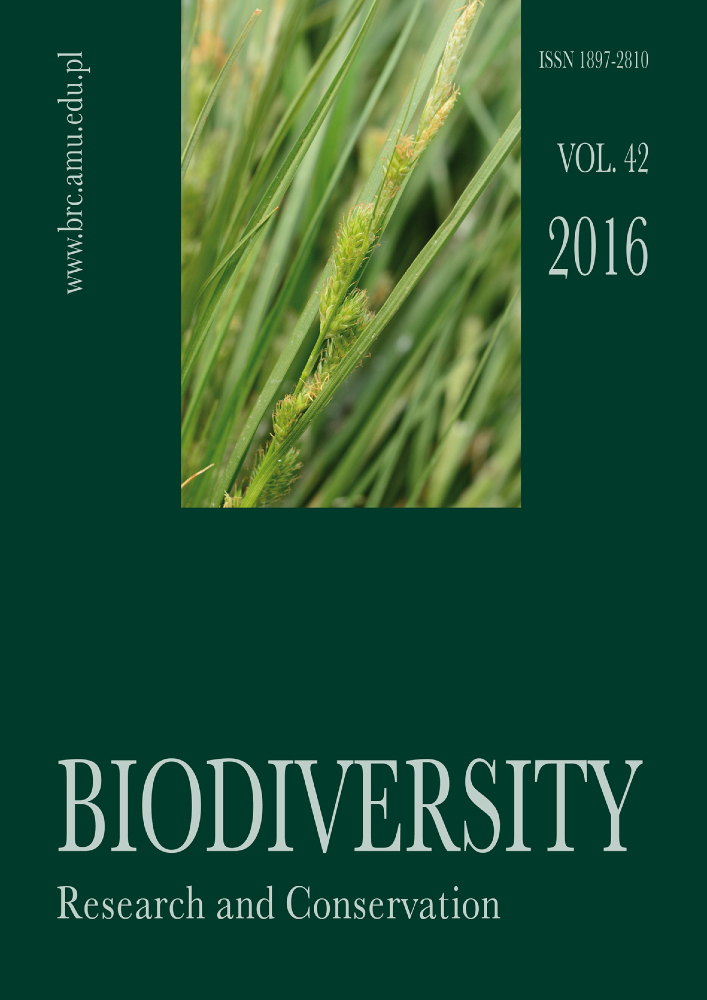Abstract
Vegetation data (70 relevés) of ephemeral wetlands collected in both permanent and temporal water basins were analyzed. Numerical classification of the data revealed two distinct subsets, the first comprised communities of Eleocharition ovatae Philippi 1968 alliance, the second combined communities dominated by Alisma lanceolatum, Isolepis supina or Elatine alsinastrum (Alisma lanceolatum group). Phytocoenoses of Eleocharition ovatae were widely distributed in the study area and developed, most frequently, on exposed bottoms of fishponds. This group could be divided into four types of communities. Patches representing Alisma lanceolatum group were found only in mid-field depressions periodically filled with water and concentrated in Volhynian Upland. In this group, two lower vegetation units were distinguished.
References
Braun-Blanquet J. 1964. Pflanzensoziologie. Grundzüge der Vegetationskunde (3-rd edition). 865 pp. Springer Verlag, Vienna.
Borhidi A., Kevey B. & Lendvai G. 2012. Plant communities of Hungary. 544 pp. Akadémiai Kiadó, Budapest.
Brullo S. & Minissale P. 1998. Considerazioni syntassonomiche sulla classe Isoeto-Nanojuncetea. Itinera Geobotanica 11: 263-290.
Chytrý M. (ed.). 2011. Vegetace České republiky 3. Vodní a mokřadní vegetace. 827 pp. Academia, Praha.
Deil U. 2005. A review on habitats, plant traits and vegetation of ephemeral wetlands - a global perspective. Phytocoenologia 35: 533-705.
Fijałkowski D. 1961. Zbiorowiska roślinne jeziora Bartków w woj. lubelskim. Ann. Univ. M. Curie-Skłodowska, Sect. C, 16(4): 77-89.
Fijałkowski D. 1966. Zbiorowiska roślinne lewobrzeżnej doliny Bugu w granicach województwa lubelskiego. Ann. Univ. M. Curie-Skłodowska, Sect. C, 21: 247-312.
Fijałkowski D. 1967. Zbiorowiska roślin synantropijnych miasta Lublina. Ann. Univ. M. Curie-Skłodowska, Sect. C, 22(17): 195-233.
Fijałkowski D. 1978. Synantropy roślinne Lubelszczyzny. 260 pp. PWN, Warszawa-Łódź.
Fijałkowski D. 1991. Zespoły roślinne Lubelszczyzny. 303 pp. Wyd. UMCS, Lublin.
Fijałkowski D. & Kozak K. 1970. Roślinność rezerwatu „Torfowisko nad Jeziorem Czarnym Sosnowickim”. Ann. Univ. M. Curie-Skłodowska, Sect. C, 25(20): 213-241.
Fijałkowski D., Bloch M., Flisińska Z., Nycz B., Polski A. & Wójciak H. 1992. Flora i zespoły projektowanego rezerwatu Bagno Rakowskie. Ann. Univ. M. Curie- Skłodowska, Sect. C, 47(14): 199-237.
Fijałkowski D., Matuszkiewicz A. & Polski A. 1995. Szata roślinna projektowanego rezerwatu Stawy Wilczowskie. Ann. Univ. M. Curie-Skłodowska, Sect. C, 50(4): 71-89.
Fijałkowski D. & Polski A. 1990. Stosunki geobotaniczne rezerwatu Lasy Janowskie. Ann. Univ. M. Curie- Skłodowska, Sect. C, 45 (16): 197-228.
Hrivnák R., Slezák M., Šubmerowá K. & Hroudová Z. 2015. A new marsh plant community of Eleocharito palustris-Alismatetum lanceolati (Eleocharito palustris- Sagittarion sagittifoliae alliance) in Slovakia. Acta Soc. Bot. Pol. 84(3): 311-319.
Jarolímek I., Šibík J., Hegedüšová K. Janišová M., Kliment J., Kucera P., Májeková J., Michálková D., Sadlonová J., Šibíková J., Škodová I., Uhlírová J., Ujházy K., Ujházyová M., Valachovic M. & Zaliberová M. 2008. A list of vegetation units of Slovakia. In: I. Jarolímek & J. Šibík (eds.). Diagnostic, constant and dominant species of the higher vegetation units of Slovakia, pp. 295-329. Veda, Bratislava.
Kępczyński K. & Rutkowski L. 1991. Występowania Alisma lanceolatum With. w różnych zbiorowiskach roślinnych na terenie otaczającym dolną i środkową Wisłę. Acta Univ. Nicolai Copernici, Biologia 38: 93-103.
Kępczyński K. & Rutkowski L. 1993. Zbiorowiska namuliskowe brzegów śródpolnych oczek, stawów wiejskich i małych jezior w niektórych regionach środkowowschodniej części Pojezierzy Południowobałtyckich. Acta Univ. Nicolai Copernici, Biologia 42: 3-30.
Kondracki J. 2002. Geografia regionalna Polski. 441 pp. Wyd. Nauk. PWN, Warszawa.
Libbert W. 1932. Die Vegetationseiheiten der neumärkischen Staubeckenlandschaft unter besonderer Berücksichtigung der angrenzenden Landschaften. I. Verh. Bot. Ver. Prov. Brandenburg 74: 10-93.
Matuszkiewicz W. 2011. Przewodnik do oznaczania zbiorowisk roślinnych Polski. In: J. B. Faliński (ed.). Vademecum Geobotanicum, 3, 537 pp. Wyd. Nauk. PWN, Warszawa.
Mirek Z., Piękoś-Mirkowa H., Zając A. & Zając M. 2002. Flowering plants and pteridophytes of Poland. A checklist. In: Z. Mirek (ed.). Biodiversity of Poland, 1, 442 pp. W. Szafer Institute of Botany, Polish Academy of Sciences, Kraków.
Pietsch W. 1973. Beitrag zur Gliederung der europäischen Zwergbinsengesellschaften (Isoëto-Nanojuncetea Br.- Bl. et Tx. 1943). Vegetatio 28: 401-438.
Popiela A. 1997. Zbiorowiska namułkowe z klasy Isoëto- Nanojuncetea Br.-Bl. Et Tx.1943 w Polsce. Monogr. Bot. 80: 1-59.
Popiela A. 2005. Isoëto-Nanojuncetea species and plant communities occurring on their eastern distribution range (Poland). Phytocoenologia: 35(2-3): 283-303.
Popiela A. & Fudali E. 1996. The community with Elatine alsinastrum (the Isoëto-Nanojuncetea-class) in the town Chojna environs in the western Pomerania (NW Poland). Fragm. Flor. Geobot. 41(2): 771-774.
Popiela A., Prajs B. & Łysko A. 2010. New data on distribution of dwarf ephemeral wetland vascular plant species/communities in the western and north-western Poland. Biodiv. Res. Conserv. 14: 35-40.
Šubmerová K. & Hrivnák R. 2013. Formalised classification of the annual herb vegetation of wetlands (Isoëto-Nano- Juncetea class) in the Czech Republic and Slovakia (Central Europe). Phytocoenologia 43(1-2): 13-40.
Taran G. S. 1995. A little known vegetation class of the former USSR - flood-plain Ephemeretum (Isoëto- Nanojuncetea Br.-Bl. et Tx. 43). Siberian Journal of Ecology 2(4): 372-380.
Täuber T., Bruns E. & Steinhoff K.-J. 2007. Wiederfund des Elatino alsinastri-Juncetum tenageiae Libb. 1932 in Niedersachsen - Lebensbedingungen, Syndynamik und Schutzbemühungen. Hercynia N.F. 40: 269-278.
Trąba C. 1991. Zbiorowiska roślinne ściernisk w południowowschodniej Polsce. Cz. IV. Zbiorowiska ze związku Nanocyperion flavescentis. Acta Agrobot. 44(1-2): 171-193.
Zając M. & Zając A. 1988. Zbiorowiska z klasy Isoëto- Nanojuncetea na dnach wysychających stawów w południowej części Kotliny Oświęcimskiej. Zeszyty Naukowe UJ, Prace Botaniczne 17: 155-160.
Zlacká S., Sádovský M., Dítě D. & Eliáš P. 2006. Súčasné poznatky o výskyte a cenologických väzbách Schoenoplectus supinus (Cyperaceae) na Slovensku. Bull. Slov. Bot. Spolocn. 28: 149-158.




